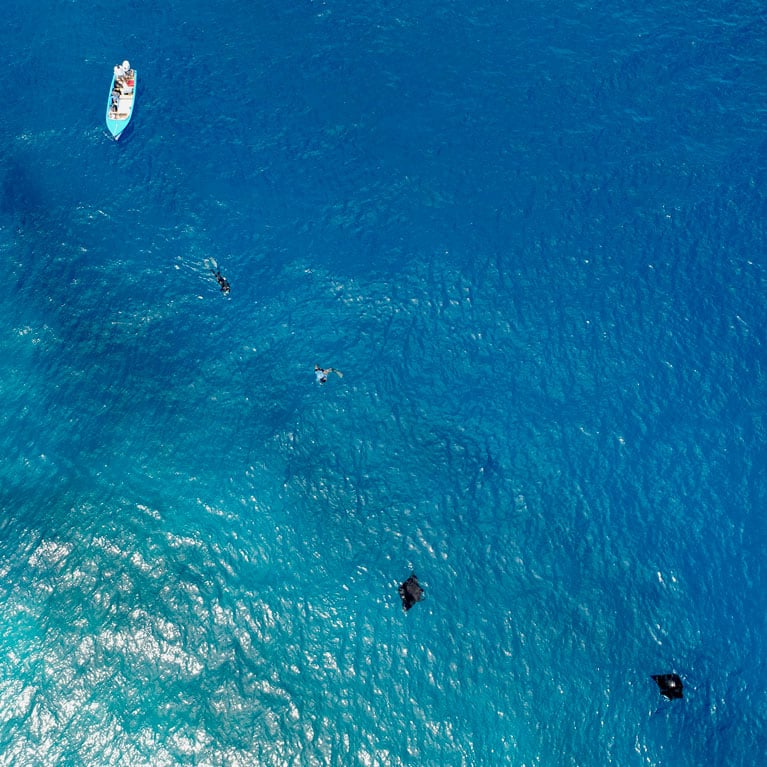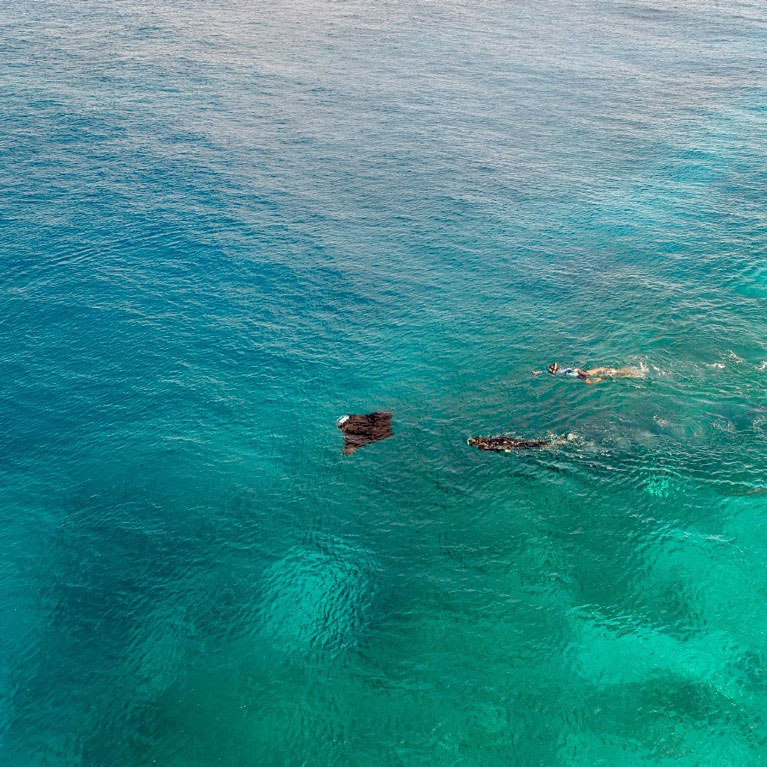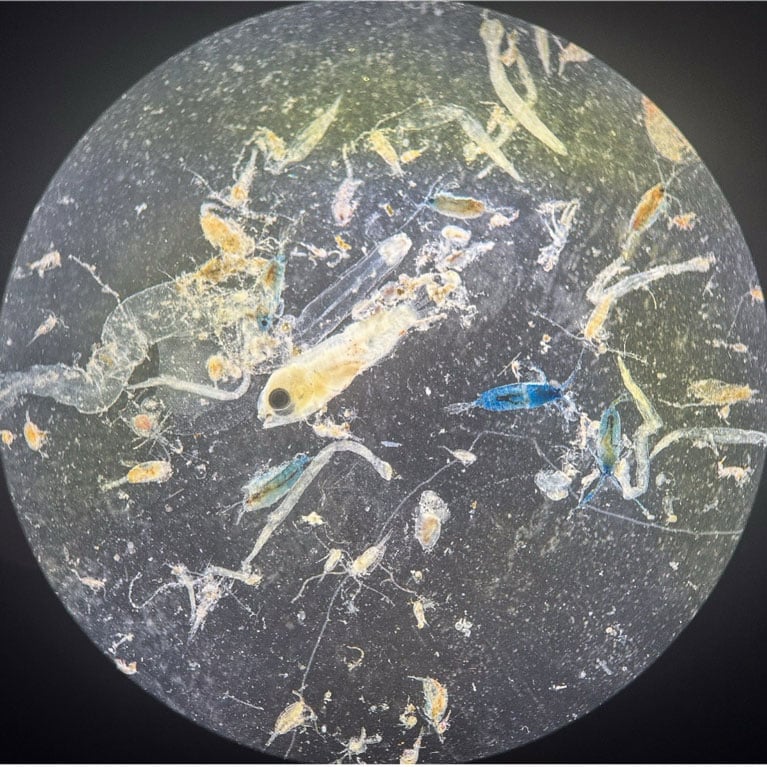On reef manta time at D’Arros, Seychelles
Questions of how climate change, human disturbances and habitat alterations might affect how reef manta rays use their coral reef homes can only be answered if we understand the intricacies of how they live now. Rachel is looking to answer those questions using novel biologging technology, devising methods of attaching the devices safely onto wild reef mantas and then tracking the animals’ time-energy budgets. She hopes her information about how, when and where reef manta rays are spending their time will aid future risk assessments for them.
Growing up on the coast of Western Australia in Perth, I always had a love for and fascination with the natural environment, particularly the ocean. My parents were both environmentalists and because of this I was fortunate to grow up exploring remote places around the world. Some of my fondest memories revolve around these experiences. At the age of 12 I begged my parents to let me learn how to scuba dive, and it was being immersed in the marine environment that helped me solidify the sense of wonder and curiosity that has driven me to learn more...



Fine-scale activity and behaviour regimes of reef manta rays in the Anthropocene
To quantify the behaviour and activity regimes of free-swimming reef manta rays within a marine protected area at D’Arros Island, Seychelles, using novel biologging devices. We aim to understand the spatio-temporal patterns in time–energy budgets of the manta rays; gain insights into their functional ecology at coral reefs; and quantify the overlap of key behaviours within the marine protected area.
The reef manta ray is a threatened species, yet we have no detailed understanding of how much time and energy it spends on key life-history processes. The factors that determine behaviours and their costs are crucial to predict and mitigate how human disturbance, climate change and habitat alteration impact these rays. Isolated as it is, D’Arros Island offers a unique opportunity to gather important information about the energetics of reef manta rays within a relatively undisturbed area, thus providing an important global baseline. We also know little about what drives high rates of residency and site fidelity in manta rays. By identifying the physical and biological processes that influence the species’ movements and behaviour, as well as estimating the energetic costs underlying specific behaviour, this study will improve our ability to recognise critical habitats for reef manta rays and provide a broader understanding of what determines their movements and ecological role in coral reef systems in Seychelles and on a global scale.
The reef manta ray is a large mobulid ray with a tropical and subtropical distribution throughout much of the Indian and Pacific oceans. It is typically resident in productive near-shore environments, such as coral and rocky reefs of island groups, atolls and continental coastlines. Although individuals are capable of long-distance movements of up to 1,150 kilometres (715 miles), they seldom travel so far. There is low connectivity between widely separated sites and a high degree of residency, which makes the reef manta ray vulnerable to local depletion, which may lead to regional extinction.
Given the potential for reef manta rays to influence nutrient flow, their disappearance from aggregation sites may negatively affect local reefs. Whereas many reef-associated species forage over short distances within coral reefs, reef manta rays travel longer distances to feed on zooplankton communities offshore. This foraging behaviour, coupled with the rays’ residency at aggregation sites, may facilitate the transport and recycling of nutrients between isolated reefs and offshore environments, benefiting coral growth and productivity within these reef systems. Our current understanding of the feeding ecology of reef manta rays, however, has relied on indirect and/or passive measures of foraging behaviour. Fine-scale multi-sensor tag technology will enhance our knowledge.
The aggregation of reef manta rays at D’Arros Island provides an opportunity to document the behavioural and energetic baselines for the species, which are necessary to subsequently quantify anthropogenic threats. D’Arros is a significant aggregation site for reef manta rays and since 2013 has been the focus of a programme monitoring their movement patterns and foraging behaviour within the archipelago. Until now, it has not been possible to quantify the rays’ behavioural regimes at this site, but the development of biologging tags that can be mounted on wild animals without the need for capture has now made this possible. For the first time, we have the opportunity to better understand the drivers of behaviour and habitat use patterns of reef manta rays in the Seychelles, and the functional role that these rays may play in coral reef environments.
- To develop tag application equipment and methods to mount biologging devices on wild, free-swimming reef manta rays.
- To deploy biologging packages on more than 20 reef manta rays at D’Arros Island.
- To generate time-activity budgets for individual manta rays and describe these activity regimes relative to known behaviours for the species.
- To quantify the movement patterns of tagged individuals through dead-reckoning and passive acoustic telemetry to describe the spatio-temporal patterns of time-activity budgets for reef manta rays, and to examine how environmental conditions and habitat features at D’Arros Island influence reported time–activity budgets for these rays.
- To discuss the time–activity budgets for reef manta rays relative to their bio-energetic requirements and functional role within local reef systems at D’Arros Island and consider how these findings inform the implementation and management of the D’Arros Marine Protected Area.
- To explore how spatio-temporal patterns in time–energy budgets can support risk assessments of anthropogenic threats to the species.

